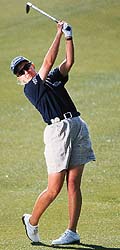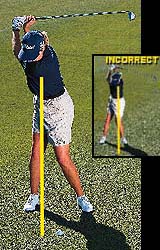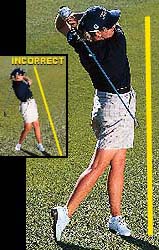
A proper weight transfer is one of the hallmarks of a good golf swing. Although I don’t fight a reverse-pivot, I don’t always turn behind the ball as much as I’d like to, which keeps my weight too centered at the top of the backswing. If I don’t move fully to my right side going back, my swing loses a lot of its power.
To set up a powerful downswing and solid impact, I think about turning my upper body over my right leg on the backswing. With my weight behind the ball, I can uncoil through impact and let the swing’s momentum pull me onto my left side at the finish. Players with a reverse-pivot cannot drive forward because their weight is already on the front foot. And since the weight tends to shift as the swing changes directions, it often slides away from the target through impact, leading to glancing contact with the ball.
If you suffer from weak ball-striking, take a look at your swing in a mirror and compare it to the photos on the following page. Then try the drill I use to check my own weight shift.
GET OUT OF REVERSE
RIGHT FOOT, LEFT FOOT

Hit several balls this way before going back to your normal swing. When you do, keep your feet on the ground but try to recreate the shift you felt during the drill‹all your weight moving to the right on the backswing and to the left through impact.



